Ringgit officially breached the psychological RM4.50 to the U.S. dollar on Sept 13, 2022 – the lowest since the 1997-1998 Asian Financial Crisis. The Malaysian currency already plunged to its 24-year low on Sept 7 when it closed at RM4.5015 to the greenback. But for the next 3 trading days, it tried to pull back to RM4.99. The central bank, despite spending billions to prop up the currency, failed.
Today (Sept 26), the Ringgit hits RM4.60 – just 10 trading days since the currency breached RM4.50 (and never looked back). This is important because it took the local currency from July 19 to Sept 13 to cross from RM4.45 to RM4.50. It had depreciated by RM0.05 in about 42 trading days, but only 10 days to lose RM0.10 to the dollar. This is what we call “free fall”.
The last time economists and analysts were worried that the Malaysian Ringgit could hit the 1997 Asian Financial Crisis was in Sept 2015 during the peak of 1MDB scandal. At that time, the Ringgit sell-off saw the currency fell by 40%, among the world’s worst performing currencies. The currency depreciation did not strengthened exports or improved the trade balance at all.
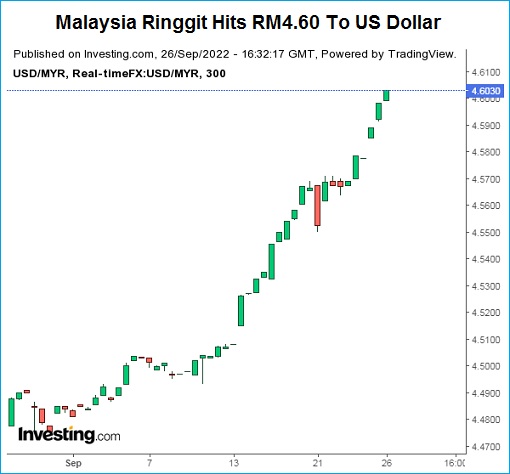
Thanks to then-PM Najib Razak’s 1MDB scandal, the Ringgit subsequently tested RM4.50, but had never succeeded in breaching the psychological level, until this month. The plunge was 100% due to the domestic political crisis – sparked by the scandal, the worst in Malaysia’s history. At current RM4.60, the value of Ringgit is worse than during 1MDB scandal and the 1997 Financial Crisis.
Yet, the clueless Finance Minister Zafrul Abdul Aziz has insisted that the country is not experiencing an economic crisis, even though the currency is hitting low levels against the US dollar. At the current rate of depreciation, the Ringgit could hit RM4.80 in another 20 trading days. If we are lucky, the currency could meet its resistance at RM4.80, otherwise it will drop like a rock to RM5.00.
Why RM4.80 to a US dollar? That’s because at its worst level, the currency plunged to a record RM4.885 per dollar in 1998, before it was pegged at 3.80 per dollar. However, the Ringgit had never established RM4.80 as its resistance level because then-PM Mahathir Mohamad quickly pegged the currency before more damage could be done to the economy.
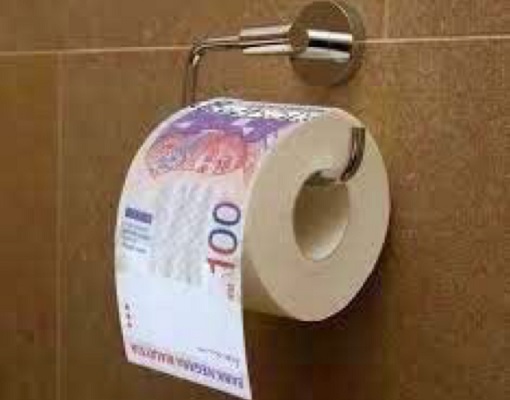
Meaning the Ringgit could free fall from RM4.50 to RM5.00 without even stop at RM4.80. From a psychological point of view, the RM4.80 might be the next resistance level, after which the next resistance level could be RM5.00. It didn’t help that political instability due to confusion over 15th General Election is spooking investors – both foreign and domestic. In short, the currency is toast.
What does this mean to you? It’s not rocket science that exportersare reluctant to convert foreign exchange earnings into Ringgit at a time when the local currency is weak. But with the Ringgit plunging from RM4.50 to RM4.60 in just 10 trading days, everyone, including YouTubers, content creators, business owners and anyone who earns US dollars should do the same.
To make matters worse, the country has external debts of RM1.3 trillion. Those US-dollar debt papers mean total interest payments alone would skyrocket due to weaker Ringgit. The three tranches of US dollar bonds totalling US$7.5 billion arranged by Goldman Sachs for 1MDB, which was raised when the Ringgit was about 3.35 per US dollar, would translate to RM21.8 billion in principal amount.

At today’s exchange rate of RM4.60, the principal amount due works out to about RM29.9 billion – RM8.1 billion more (it was just RM29.5 billion on Sept 15). In just 7 trading days, from paying RM7.7 billion more in principal amount after the Ringgit hit RM4.53, the debt has ballooned by a whopping RM400 million just because the currency depreciates by merely “7 sen” to RM4.60.
First of all, RM4.50 has now become the support level, meaning unless the U.S. dollar suddenly collapses, which is very unlikely, the Ringgit will not strengthen back to RM4.49. And it has everything to do with the U.S. Federal Reserve, which raised benchmark interest rates another 75 basis points last Wednesday (Sept 21) – the third consecutive 0.75 percentage point move.
In its desperate rush to bring down the 40-year-high inflation, the U.S. central bank took its federal funds rate up to a range of 3%-3.25%, the highest since early 2008. But the Fed was not done with the hikes. Federal Reserve Chairman Jerome Powell said the central bank will keep hiking well above the current level. The Fed is expected to raise rates by at least 1.25 percentage points in its two remaining meetings this year.
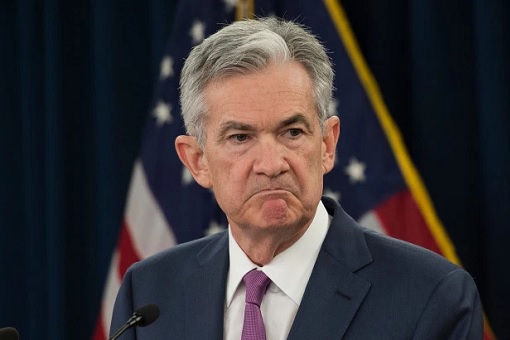
So, it could be another 75 basis points, follows by 50 basis points – or even two more 75 basis point hike – if inflation remains high. The rate hikes that started in March have been the most aggressive since it started using it as its principal policy tool in 1990. Powell said – “The FOMC is strongly resolved to bring inflation down to 2%, and we will keep at it until the job is done”.
That’s a tall order, considering that the U.S. inflation stubbornly refused to cool in August, contrary to investors’ prediction. Not only the inflation rate remains at 40-year high, it increased by 0.1% to 8.3% year-on-year for August. In July, it was 8.5% after hitting 9.1% in June – the highest inflation in 40 years after January’s 7.5%, February’s 7.9%, March’s 8.5%, April’s 8.3% and May’s 8.6%.
The median forecast showed that the Federal Reserve is expected to hike rates to 4.4% by the end of 2022. It will continue to increase interest rates as high as 4.6% in 2023, before stopping its fight against soaring inflation. However, based on the Fed’s tool called “dot-plot”, the upper range could see interest rates as high as 4.75%-5% range next year.
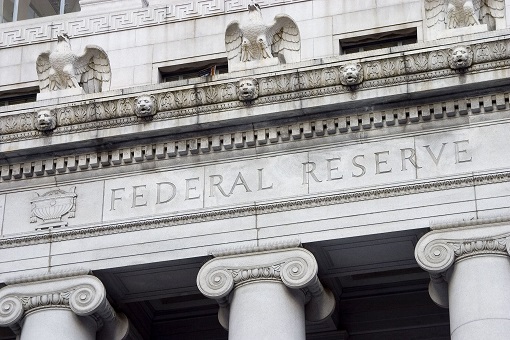
The plan, at least that’s what the Fed hopes to achieve, is to bring down inflation to 5.4% this year. With the aggressive tightening, the central bank thinks the inflation could fall to 2% by 2025. But for the last 6 consecutive months (from March to August), the inflation rate has stubbornly stayed above 8%. What are the chances it would come down to 5.4% without triggering a recession?
The Federal Reserve could be hallucinating. Core inflation – prices of goods and services “except” food and energy – actually skyrocketed to 0.6% in August. Meaning the economy was spectacularly screwed because past months of inflation were due to rising cost of energy and global food shortages. But in August, even without taking into consideration energy and food prices, the inflation shot up.
Here’s where the fun begins. After a 99-day streak of declining gas prices in the U.S., the gasoline price suddenly began to rise again on Wednesday, the same day the Fed hiked the interest rates by 75 basis points. The price jumped after Russian President Vladimir Putin declared a “partial mobilization” of 300,000 military reservists for the first time since World War II – to fight in Ukraine War.

After hitting record US$5.02 on June 14, the gasoline went up by a penny to US$3.681 a gallon last Wednesday. Today (Sept 26), the national average gas prices continue to go up to US$3.725. Aside from the war, hurricane season can also impact oil prices. A new storm forming could make its way to the Gulf of Mexico next week, impacting oil production and refineries.
Sure, the gas price increase is minimal, but Treasury Secretary Janet Yellen has already warned that prices could shoot back up this winter. To add fuel to the fire, the U.S. is leading the Group of Seven (G7) countries to slap a price cap on Russian oil – another foolish and half-baked move that would push the energy prices higher again.
Organisation for Economic Cooperation and Development (OECD) said today (Sept 26) that global economic growth is slowing more than forecasted a few months ago in the wake of Russia’s invasion of Ukraine. While global growth this year was still expected at 3.0%, it is now projected to slow to 2.2% in 2023, revised down from a forecast in June of 2.8%.

Europe is already in a huge mess, with the OECD projected the euro zone economic growth would slow from 3.1% this year to only 0.3% in 2023. At least 19 nations of the European Union would spend the remaining of the year in a recession. Germany, the biggest economy in Europe, would see its economy contract 0.7% next year. Even the U.S. economy will slow from 1.5% this year to 0.5% next year.
China’s strict measures to control the spread of Covid-19 this year meant that its economy was set to grow only 3.2% this year and 4.7% next year, down from the OECD’s previous forecast of 4.4% in 2022 and 4.9% in 2023. China has been Malaysia’s largest trading partner for 13 consecutive years. The global economic slowdown, or worse a recession, will directly impact Malaysia, and therefore its currency.
Assuming a nuclear war between the U.S. and Russia does not happen, it is already a challenge for Bank Negara Malaysia to match the Federal Reserve rate hikes. With expectations that the U.S. has two more hikes this year, the central bank is caught in a Catch-22 situation – the Ringgit could weaken without rate hikes, but risk triggering a recession if follow through with hikes.
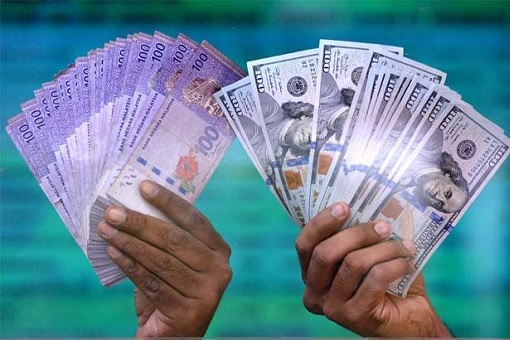
Other Articles That May Interest You …
- Ringgit In Freefall To RM4.80 – Finance Minister Zafrul Had No Clue That Imports & Debts Suffer With Stronger Dollar
- Printing RM1.9 Trillion – Why Ringgit Could Breach 4.50 And Plunge Into A Free Fall As Investors Continue To Lose Confidence
- Too Little Too Late – Bank Negara Raises Interest Rate To Rescue Tumbling Ringgit Under Pretext Of Fighting Inflation
- Ringgit Hits 2-Year Low Of 4.36 Despite High Oil Price – How UMNO Leaders Destroy The Currency In The Last 25 Years
- 7 New Taxes That Najib & UMNO Plan To Introduce After They Win The 15th General Election
- Food Prices Skyrocket – The Return Of Monopoly & Cartel Run By Rich UMNO Malay Elites To Profit From The People
- Driving Investors Away – Prolonging Covid-19 Pandemic In Malaysia Threatens Global Semiconductor Supply Chain
- Congrats Muhyiddin! – Here Are The Letters From German, Japanese And Dutch Investors Threatening To Pull Out
- The Worst Is Yet To Come – Muhyiddin’s Mishandling Of Covid-19 & Mismanagement Of Economy Is Worse Than Trump
- Printing Money – The Stupid Backdoor Deputy Minister Who Thought Malaysia Ringgit Is As Powerful As US Dollar
- Get Ready For Bad Time Ahead! – As Malaysia’s Economy & Corporate Debt Get Worse, Retrenchment Has Just Begun

|
|
September 26th, 2022 by financetwitter
|


|

|

|

|

|

|




























Comments
Add your comment now.
Leave a Reply